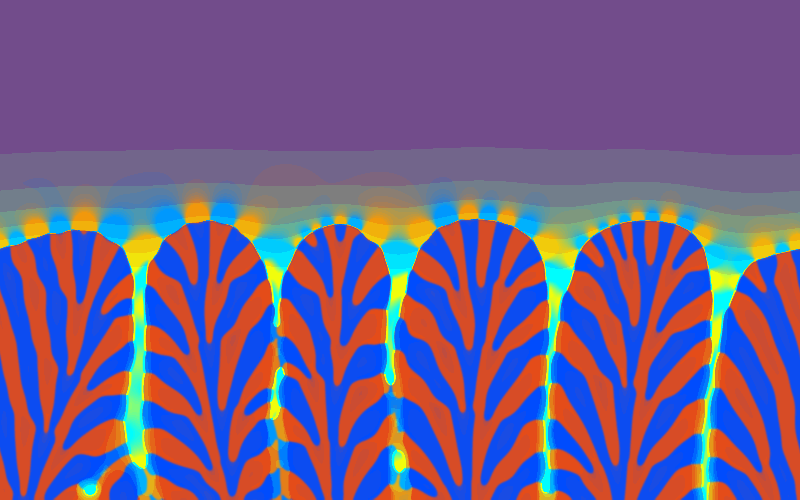
Alain Karma and Mathis Plapp,
Northeastern University, Boston, Massachusetts
Research Objectives
Our research aims at understanding the complicated spontaneous pattern formation processes occuring during the growth of solids. Examples for such phenomena are the dendritic or eutectic microsctructures formed when an alloy is directionally solidified, or the growth spirals observed during epitaxial thin-film growth. The particular difficulty common to all these diffusion-limited processes is the presence of moving phase boundaries of complex and changing shape. We use the phase-field method to investigate these notoriously difficult free boundary problems.
Computational Approach
The traditional formulation of free boundary problems in terms of mathematically sharp interfaces between different thermodynamic phases is difficult to implement because of the problem of front tracking. The phase-field method introduces indicator fields (or phase fields) and allows for a finite interface thickness. The equations of motion become nonlinear partial differential equations which can be solved using standard methods. In this setting, the problem can be very easily parallelized. We simulated systems of considerable complexity on the NERSC T3E.
Accomplishments
We have investigated the influence of the surface tension anisotropy on the dynamics of pattern selection during the directional solidification of a binary alloy. Whereas the importance of this anisotropy is well documented for free dendritic growth, only recently its role in directional solidification was recognized. The possibility to simulate large arrays of solidification cells allowed to monitor the complete dynamics of spacing selection, starting from a slightly perturbed interface as is usually the case in experiments. In particular, it was shown that recently discovered multiplet cells can be dynamically selected if the initial perturbation has a fixed periodicity. These results are in excellent agreement with recent experiments where a perturbation of fixed wavelength is imposed at the beginning of the solidification process using a modulated laser beam.
We have also developed a phase-field model for the directional solidification of eutectic alloys with an additional ternary impurity. Simulations show the development of large two-phase eutectic cells, in agreement with experiments. The dynamics of eutectic cell ("colony") formation is at present ill understood and can be further investigated with our model.
As an extension of our main project, we have recently adapted the phase-field method to model step-flow growth on facetted crystal surfaces. The step dynamics in epitaxial thin-film growth is governed by the interplay of the flux of deposited atoms, the surface diffusion and the desorption from the surface. In particular, we have investigated the dynamics of spiral ridges around screw dislocations. Whereas these spirals are well understood in the regime where desorption is dominant, our method allows to investigate the opposite case, relevant for molecular beam epitaxy, where surface diffusion is dominant.
Significance
Both directional solidification and epitaxial growth are important industrial methods for advanced materials fabrication. Many properties of the final material are largely influenced by the microstructure of the material, which in turn is determined by the dynamics of the growth front. Understanding the influence of various control parameters on the growth dynamics is therefore of great practical importance.
Publications
A. Karma and W.-J. Rappel, Quantitative Phase-Field Modeling of Dendritic Growth in Two and Three Dimensions, Phys. Rev. E 57, 4323-4349 (1998)
G. W. Losert, D. A. Stillman, H. Z. Cummins, P. Kopczynski, W.-J. Rappel, and A. Karma, Selection of Doublet Cellular Patterns in Directional Solidification through Spatially Periodic Perturbations, Phys. Rev. E, in press (1998)
A. Karma and M. Plapp, Spiral Surface Growth Without Desorption, Phys. Rev. Lett., in press (1998)
Related information can be found at http://www.circs.neu.edu.

The image shows eutectic two-phase cells, or colonies, which form
during the directional solidification of a binary eutectic alloy
with a ternary impurity. The growth direction is from bottom to
top; the two solid phases are shown in red and blue. The dynamics
of the interface is determined by the diffusion through the liquid
(violet). The concentration of the ternary impurities in the liquid is
shown as intensity levels in green. Yellow and light blue regions in the
liquid indicate a strong concentration of "red" or "blue" atoms.